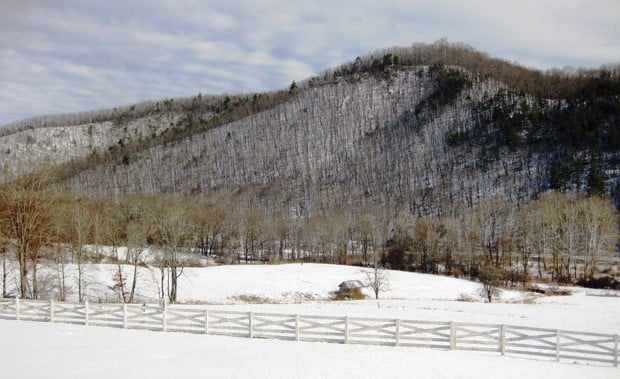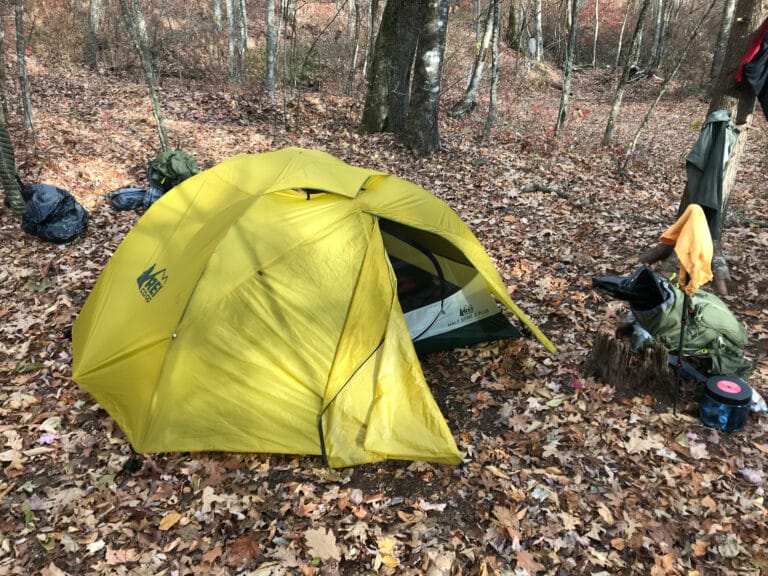Sleep Mountain, aka Mount Anonymous, aka the mountain rises from the Greenbrier River.
As far as the U.S. Board on Geographic Names is concerned, this is a story about an unnamed feature in a wilderness area. But I’ll let you in on a secret. It’s really a story about a group of friends and a tiny little mountain in West Virginia that—in spite of its unassuming swirls on a topo map—became an absurd adventure: Sleep Mountain.
In 2009, while planning an annual outing, my friend Lowrie mentioned his family owned a cottage in West Virginia overlooking the Greenbrier River. With his usual understated nature, he mentioned the fishing was OK in the fall and asked if I wanted to check it out.
So the trips to Spice Run began.
As we unloaded our gear onto the porch that November, there looking back at us from the Monongahela National Forest was Sleep Mountain. Back then, when it was the unnamed feature, it presented an obtuse triangle. The riverside face was extremely steep, as was the northern end. The peak fell into a ridge on the southern side, then down again to the river.
“We should go climb that sucker in the morning,” Lowrie suggested.
We had come for the low-hanging fruit, though, and it was everywhere. Ahead was the 80-mile Greenbrier River Trail, one of the most picturesque rails-to-trails projects in the eastern United States. After five minutes on the trail, a bald eagle flew overhead. As we followed its flight over the river, we noticed a 400-pound black bear foraging on the opposite bank. The river, then waist-deep and quite warm, was teeming with smallmouth bass.
That night, we settled in on the porch and caught up on the last year of each other’s lives. The stars cast a net over us in the black sky, but nothing was quite as black and suddenly imposing as the mountain. We resolved to climb it. Some other time.
As the months and years went on and more people were introduced to the paradise, talk of climbing the mountain became more serious. Trek down to the river, cross it, pick your way up about a thousand feet and be back for lunch. Next time.
The landscape was covered in snow when we visited last January. The four-wheel-drive thrill ride just to get to the cottage shaved years from our lives. We had to post-hole through an exhausting quarter-mile just to get to the river, only to find it frozen. We couldn’t have the mountain, which was maddening. The mountain gained personality and presence through our frustration.
In the mornings, we filled our coffee cups and greeted the mountain as we watched the sun come up over it. On the porch, we talked to each other while staring at the mesmerizing summit. It might as well have been sitting there beside us.
And so, when we came to visit the mountain this November, there was only one thing to do.
Lowrie and I and two friends, Matt and Reny, set out early in the morning with a canoe. Once on the opposite shore, we tossed plans to switchback up the mountain and headed straight for the summit.
Sucking wind at the peak, we flopped on our backs and stared at the sky before closing our eyes. Thus the mountain was named.
Back at the house, talk turned to putting our stamp on the next revision of the U.S. Geological Survey area map. It was a suggestion made in jest, but it piqued my curiosity. My next day back in civilization, I began researching the process and contacted the naming board. So started an exchange plucked from the pages of Heller’s Catch-22.
Unbeknownst to us, around the time of our first visit, this part of the Monongahela had been designated a wilderness area. As such, I was directed to the austere “Policies and Procedures: Domestic Geographic Names, Chapter 3, Policy IV.” I was advised that “the Board strongly discourages naming unnamed features in wilderness areas so as to preserve the wilderness aspect; however, it is not out of the question if there is an overriding need especially for purposes of safety, but otherwise no.”
Before we knew any better, we had named the unnamed feature. Oops.
I have been asked why we felt entitled to name the mountain and it’s a fair question. Although I poke fun at the naming regulations, I respect and appreciate the protections afforded by the designation of a wilderness area. The naming was a matter of respect, not one of entitlement.
Everyone knows someone who has cleverly named his pet “dog,” or “cat,” or worse—someone who calls his child “the boy,” or “the girl.” It makes me cringe. For the Spice Run crew, calling it “the mountain” any longer would have been unacceptable.
Sulking in the thought we had ruined the wilderness area, I recently searched the USGS Geographic Names Information System. Red Sleep Mountain rises in Montana. Sleepy Mountain sits in Alabama. Five summits in the country are named after Sleeping Beauty. Of the 23 summits with some iteration of “sleep” in their names, I was comforted to discover six are smaller than our puny 2,621-foot peak.
Still no Sleep Mountain, though. At least not on a map.








